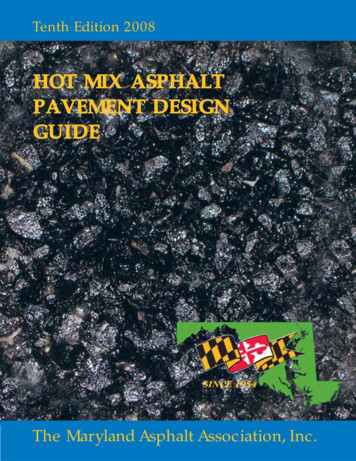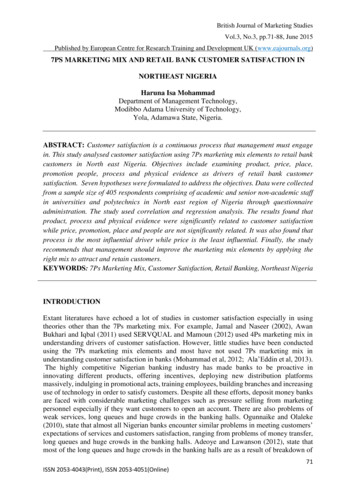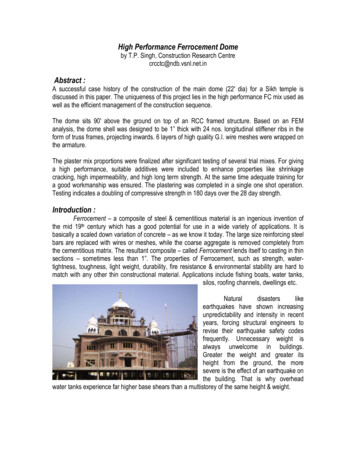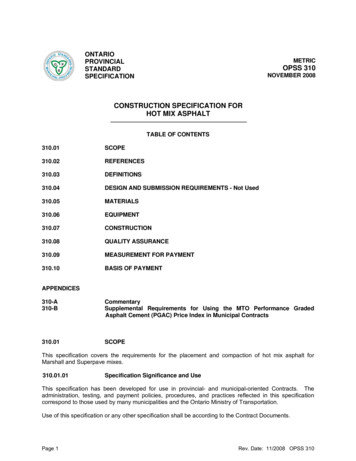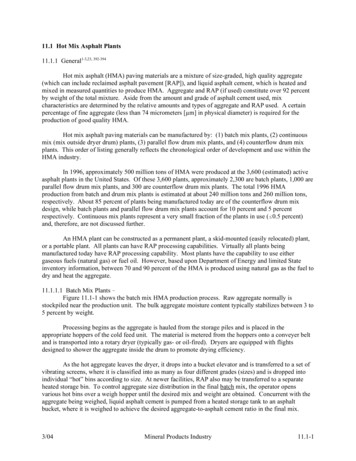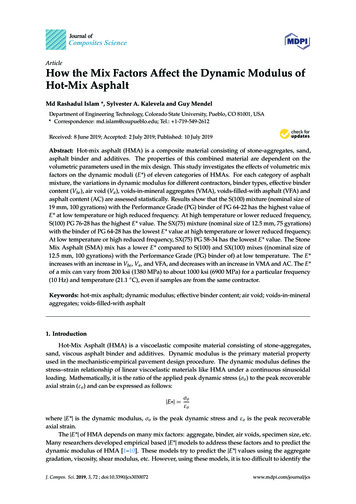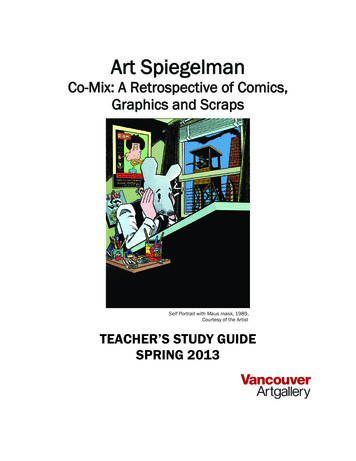
Transcription
Art SpiegelmanCo-Mix: A Retrospective of Comics,Graphics and ScrapsSelf Portrait with Maus mask, 1989,Courtesy of the ArtistTEACHER’S STUDY GUIDESPRING 2013
ContentsProgram Information and Goals. 3Background to the Exhibition . 4Artist Background . 5Comics 101: A Short History of Comics in America . 6Background to the Holocaust . 8Background information: Spiegelman Family . 10Preparation for the Exhibition: Classroom Discussions and Activities1. Why Spiegelman? . 11Art Spiegelman Says . 122. Understanding Comics . 133. Maus . 154. The Covers . 18Readings for The Covers . 20Vocabulary . 22Resources . 23Illustration for Joseph Moncure March’sThe Wild Party (1928), 19942
Vancouver Art GalleryTeacher’s Guide for School ProgramsArt Spiegelman has been credited with bringing comic books out of the toy closet and ontothe literature shelves. Art Spiegelman, Co-Mix: A Retrospective of Comics, Graphics andScraps is the first major retrospective of the acclaimed American comic artist. The exhibitionincludes drawings, sketches and panels from his earliest underground comix, his PulitzerPrize-winning comic memoir Maus, New Yorker covers and most recent illustrations. Thework is intricate and dynamic, with its shifting graphic style, formal complexity andcontroversial content. It defies easy categorization as it challenges us to ask questions aboutthe relationships between word and image, content and form, high art and popular culture.DEAR TEACHER:This guide is essential in preparing for your tour of the exhibition Art Spiegelman, Co-Mix: ARetrospective of Comics, Graphics and Scraps. It will provide content and context forsome of the controversial and complex issues that Spiegelman presents in his work.It also provides follow-up activities to facilitate discussion after your Gallery visit. Engaging inthe activities before and after your visit will reinforce ideas generated by the tour and buildcontinuity between the Gallery experience and your ongoing work in the classroom.Underlined words in this guide are defined in the Vocabulary section.The tour of Art Spiegelman, Co-Mix: A Retrospective of Comics, Graphics and Scrapshas three main goals: To introduce students to the complexity and diversity of Art Spiegelman’s work , To present his body of work within the broader context of the medium of comics, To explore individual works from their political, historical and social perspectives.The Collector, Lithograph, 1979Education Program in partnership with the Vancouver Holocaust Education Centre3
THE EXHIBITION:Art Spiegelman, Co-Mix:A Retrospective of Comics, Graphics and ScrapsCo-Mix: A Retrospective of Comics, Graphics and Scraps contains 400 works from all areasof Spiegelman’s varied career. The exhibition includes preparatory drawings, sketches,studies and panels relating to his early underground comix from the 1970s, his best-knownand most challenging and acclaimed work, Maus, and his more recent illustrations andcomic art, including his powerful response to 9/11, In the Shadow of No Towers.Spiegelman credits MAD magazine as his earliest comic influence. In its formative daysunder the comic artist Harvey Kurtzman, MAD contained biting and subversive culturalcommentary. In the early ’70s, Spiegelman came into contact with the underground comixscene and prominent comic artist Robert Crumb. Both of these influences can be seen in hisearly work in Arcade magazine, an underground comix anthology. Drawing on a wide range ofartistic styles and strategies, Spiegelman developed dynamic new ideas within the field ofcomics. For twenty years he worked for the Topps Company, makers of Bazooka bubblegum,dreaming up novelty items for popular series including Garbage Pail Kids.A significant portion of the exhibition is devoted to Maus, the work that took the artistthirteen years to complete. Published between 1978 and 1991, this autobiographicalgraphic novel gives Spiegelman's father's account of his experience during World War II, astold by his son. Rather than a first-person account of the Holocaust, it is the story of the childof survivors, and included the author’s personal struggles as well as the fraught father-sonrelationship. Controversies surrounding the Pulitzer Prize-winning Maus included not onlyusing the comic form to deal with as serious a subject as the Holocaust but also drawing thecharacters with animal heads Jews as mice, Germans as cats and Poles as pigs to namebut a few. Spiegelman's narrative and formal innovations in Maus have influenced an entirenew generation of comic artists. The exhibition includes research material, preliminarysketches, photographs and storyboards related to the production of Maus.Spiegelman originally published sections of Maus in Raw, a cutting-edge magazine that hecreated and edited along with his wife and collaborator Françoise Mouly from 1980 to 1991.Raw included work by comic artists from around the world, many of whom Spiegelmanmentored and who would later receive considerable acclaim. Included in the exhibition aredesigns, pages and publications that reveal Raw's legacy.The final section of the exhibition reflects on Spiegelman's production since the publicationof Maus, including his commercial work for The New Yorker magazine, his Little Litanthologies for children and his most recent book-length efforts, In the Shadow of No Towersand Portrait of the Artist as a Young %@?*!.This exhibition is co-produced by the Vancouver Art Gallery in collaboration with the LudwigMuseum, Köln, and the Jewish Museum, New York, and is curated by guest curator RinaZavagli-Mattotti.4
ARTIST BACKGROUNDArt Spiegelman was born in Sweden in 1948 and immigrated with his family to New York in1951. His childhood interest in comics continued to grow and he began cartooning in 1960,imitating the style of his favourite comic books. As an honours student at junior high schoolhe produced a parody of MAD magazine called Blasé. He began drawing professionally at agesixteen. Among his formative influences he names MAD magazine, popular horror comics,underground comix, television and Pop Art, as well as “high” art.Despite his parents’ aspirations for him to be a dentist, Spiegelman’s focus on the comicworld was unwavering. He studied art and philosophy at university before becoming part ofthe underground comix subculture of the 1960s and ’70s. As creative consultant for ToppsCompany from 1965 to 1987, Spiegelman created series such as Wacky Packages andGarbage Pail Kids, producing trading cards, stickers and candy products.In 1974–1975, Spiegelman taught a studio cartooning class at the San Francisco Academyof Art. He was quoted as saying, “As an art form the comic strip is barely in its infancy. So amI. Maybe we'll grow up together.” Throughout his life, Spiegelman has worked tirelessly as anadvocate for greater comic literacy.From 1978 to 1987, Spiegelman taught at the School of Visual Arts in New York alongside hiscomic-making heroes Harvey Kurtzman and Will Eisner. In 2007 he was granted a Fellowshipat Columbia University and taught a Masters of the Comics seminar. In 1980, Spiegelmanand his wife, Françoise Mouly, founded Raw, the acclaimed avant-garde comics magazine.Maus I was originally serialized in Raw, before being printed as a graphic novel in 1986. In1991 Maus II was published. Maus I & II, which told the story of his father’s Holocaustexperience as told to him (Spiegelman), took him thirteen years to complete. In 2011 hereturned to the subject with a book titled MetaMaus, in which he addresses many of thequestions and controversies that have followed him since Maus’s publication, as well asproviding additional autobiographical background and the original interviews.In 1992 he began working as contributing artist for The New Yorker, working alongside hiswife Françoise Mouly as Art Editor. He made several high-profile and often controversialcovers. In 2004 he published his response to 9/11, In the Shadow of No Towers, and in2005 a comix-format memoir, Portrait of the Artist as a Young %@&*!, which incorporatessome of his most significant early underground comix.In 1997, Spiegelman wrote his first children's book, Open Me.I'm a Dog a pop-up book witha leash that attempts to convince readers that it is really a dog. Since then Spiegelman hascollaborated with Mouly on various comic projects for children.Both Spiegelman and Maus have won numerous awards. In 1992 the Pulitzer Prize wasawarded to Spiegelman for Maus the first and only time the prestigious journalism prize hasbeen awarded to a comic/graphic novel. In 2009, Maus was chosen by the Young AdultLibrary Association as one of its recommended titles for all students. In 2005, Spiegelmanwas named one of Time magazine’s 100 Most Influential People. He was made a Chevalierde l’Ordre des Arts et des Lettres in France in 2005 and even got to play himself on anepisode of The Simpsons in 2008. In 2011, Spiegelman won the Grand Prix at theAngoulême International Comics Festival, marking only the third time an American hasreceived the honour (the other two were the famed comic artists Will Eisner and RobertCrumb).5
Comics 101: A Short History of Comics in America1895: Publication of “The Yellow Kid,” a weekly cartoon in a newspaper; it becameenormously popular, followed by many more strips1930s: Superheroes change the comics world: Superman appears in 1938, one of the most important events in comics history Batman arrives the following year1940s: Comics in the postwar period are distinctly patriotic; titles include Captain America,Plastic Man, Flash, Green Lantern; conservative comics such as Archie becamepopular Will Eisner, widely considered one of the greatest comic writers in the history of themedium, publishes The Spirit1950s: Mainstream genres widely available are romance comics and Western comic books,coexisting with the more marginal and less marketable genres of horror, crime andscience fiction The rise of MAD magazine; under Harvey Kurtzman it was a radical critique ofmainstream America Few superheroes survive: Captain Marvel and DC’s Superman, Batman and WonderWoman Dr. Fredric Wertham publishes the influential book Seduction of the Innocent,indicting the comic book industry and blaming juvenile delinquency on comics andother mass media; included were fear-mongering claims such as the relationshipbetween Batman and his teenage sidekick, Robin, promoted homosexualityFrom Seduction of the Innocent by Fredric Wertham (1954):¾ “Comic books are definitely harmful to impressionable people, and most youngpeople are impressionable.”¾ “The most subtle and pervading effect of crime comics on children can besummarized in a single phrase: moral disarmament.”¾ “The superman conceit gives boys and girls the feeling that ruthless go-gettingbased on physical strength or the power of weapons or machines is the desirableway to behave.”¾ “I think Hitler was a beginner compared to the comic-book industry.”¾ “The time has come to legislate these books off the newsstands and out of thecandy stores.” In response, comic book publishers develop and introduce the "Comics Code," selfmonitoring guidelines for acceptable and unacceptable content1960s: The return of the superheroes, now layered with human failings and new challenges,aimed at children and sold in drugstores across North America Jack Kirby, another big name in comics, works with Stan Lee to create the FantasticFour, along with Spider-Man, Avengers, X-Men and other Marvel successes The ’60s also sees the proliferation of the underground comix scene, expressingdiscontent with the conservative core values of American society and sold wherevercounter-culture items are found; the most durable title was Zap Comix, created byRobert Crumb, one of the medium’s most influential and prolific cartoonists6
1970s: Jack Kirby defects to DC Comics, then returns to Marvel comics, DC’s biggest rival Publication of Star*Reach (1971—1979), an anthology series that blends sciencefiction, adventure and formal experimentation; the new generation of cartoonists,who became big names in the mainstream, included Howard Chaykin Will Eisner’s A Contract with God, and Other Tenement Stories (1978) introduces theterm graphic novel Heavy Metal (1977) introduces European cartoonists to US audiences; someAmerican content is included, notably Matt Howarth’s hilarious serial Changes1980s: American comics industry receives considerable serious attention from the media;articles in Rolling Stone, cartoonists on television, production of film documentaries(Comic Book Confidential, 1989; The Masters of Comic Book Art, 1987), comicspublished by trade book publishers, feature films based on comic releases Marvel produces Epic Illustrated, edited by Archie Goodwin, one of the comicsindustry’s most respected editors; launches many of the best artists of the future Frank Miller's Batman: The Dark Knight Returns (1986) and Alan Moore/DaveGibbons’ Watchmen (1986—1987) deconstruct and revitalize the superhero genre Other big names include Alan Moore (Swamp Thing) and Neil Gaiman (Sandman) Art Spiegelman's Maus, published in 1986, becomes an international bestseller;Maus I was originally published in Raw, which also introduced Chris Ware, whoseAcme Novelty Library and other works are widely considered to be the state-of-the-artof the comics world1990s: Scott McCloud publishes Understanding Comics, a 215-page comic about comics asan art formStudy for the cover of RAW No. 7,The Torn-Again Graphic Mag, mixed media, c. 19857
Background to the HolocaustThe following information is from the United States Holocaust Memorial Museum website.INTRODUCTION TO THE HOLOCAUSTThe Holocaust was the systematic, bureaucratic, state-sponsored persecution and murder ofapproximately six million Jews by the Nazi regime and its collaborators. Holocaust is a wordof Greek origin meaning “sacrifice by fire.” The Nazis, who came to power in Germany inJanuary 1933, believed that Germans were “racially superior” and that the Jews, deemed“inferior,” were an alien threat to the so-called German racial community.During the era of the Holocaust, German authorities also targeted other groups because oftheir perceived “racial inferiority”: Roma (Gypsies), the disabled, and some of the Slavicpeoples (Poles, Russians, and others). Other groups were persecuted on political, ideologicaland behavioral grounds, among them Communists, Socialists, Jehovah's Witnesses, andhomosexuals.WHAT WAS THE HOLOCAUST?In 1933, the Jewish population of Europe stood at over nine million. Most European Jewslived in countries that Nazi Germany would occupy or influence during World War II. By 1945,the Germans and their collaborators killed nearly two out of every three European Jews aspart of the “Final Solution,” the Nazi policy to murder the Jews of Europe. Although Jews,whom the Nazis deemed a priority danger to Germany, were the primary victims of Naziracism, other victims included some 200,000 Roma (Gypsies). At least 200,000 mentally orphysically disabled patients, mainly Germans, living in institutional settings, were murderedin the so-called Euthanasia Program.As Nazi tyranny spread across Europe, the Germans and their collaborators persecuted andmurdered millions of other people. Between two and three million Soviet prisoners of warwere murdered or died of starvation, disease, neglect, or maltreatment. The Germanstargeted the non-Jewish Polish intelligentsia for killing, and deported millions of Polish andSoviet civilians for forced labor in Germany or in occupied Poland, where these individualsworked and often died under deplorable conditions. From the earliest years of the Naziregime, German authorities persecuted homosexuals and others whose behavior did notmatch prescribed social norms. German police officials targeted thousands of politicalopponents (including Communists, Socialists, and trade unionists) and religious dissidents(such as Jehovah's Witnesses). Many of these individuals died as a result of incarcerationand maltreatment.ADMINISTRATION OF THE “FINAL SOLUTION “In the early years of the Nazi regime, the National Socialist government establishedconcentration camps to detain real and imagined political and ideological opponents.Increasingly in the years before the outbreak of war, SS and police officials incarceratedJews, Roma, and other victims of ethnic and racial hatred in these camps. To concentrateand monitor the Jewish population as well as to facilitate later deportation of the Jews, theGermans and their collaborators created ghettos, transit camps, and forced-labor camps forJews during the war years. The German authorities also established numerous forced-laborcamps, both in the so-called Greater German Reich and in German-occupied territory, fornon-Jews whose labor the Germans sought to exploit.Following the invasion of the Soviet Union in June 1941, Einsatzgruppen (mobile killing units)and, later, militarized battalions of Order Police officials, moved behind German lines to carry8
out mass-murder operations against Jews, Roma, and Soviet state and Communist Partyofficials. German SS and police units, supported by units of the Wehrmacht and the WaffenSS, murdered more than a million Jewish men, women, and children, and hundreds ofthousands of others. Between 1941 and 1944, Nazi German authorities deported millions ofJews from Germany, from occupied territories, and from the countries of many of its Axisallies to ghettos and to killing centers, often called extermination camps, where they weremurdered in specially developed gassing facilities.THE END OF THE HOLOCAUSTIn the final months of the war, SS guards moved camp inmates by train or on forcedmarches, often called “death marches,” in an attempt to prevent the Allied liberation of largenumbers of prisoners. As Allied forces moved across Europe in a series of offensives againstGermany, they began to encounter and liberate concentration camp prisoners, as well asprisoners en route by forced march from one camp to another. The marches continued untilMay 7, 1945, the day the German armed forces surrendered unconditionally to the Allies. Forthe western Allies, World War II officially ended in Europe on the next day, May 8 (V-E Day),while Soviet forces announced their “Victory Day” on May 9, 1945.In the aftermath of the Holocaust, many of the survivors found shelter in displaced persons(DP) camps administered by the Allied powers. Between 1948 and 1951, almost 700,000Jews emigrated to Israel, including 136,000 Jewish displaced persons from Europe. OtherJewish DPs emigrated to Canada, the United States, and other nations. The last DP campclosed in 1957. The crimes committed during the Holocaust devastated most EuropeanJewish communities and eliminated hundreds of Jewish communities in occupied easternEurope entirely.United States Holocaust Memorial Museum. “The Holocaust.” Holocaust hp?ModuleId 10005143. Accessed onJanuary 21, 2013.Sketch for the front cover of the first American edition of Maus II:And Here My Troubles Began, c. 19919
Background Information: The Spiegelman Family190619121927193719371939 AugSept 1Sept 4Sept 28Nov 5Dec 2319401941Dec1942 MayJuneAug1943 SpringAug 16Aug 261944MarchMay―AugSummerAug―OctSept1945 JanFebAprilApr 29May 7Summer19461948 Feb 15Vladek Spiegelman (Art’s father) is bornAnja Zylberberg (Art’s mother) is bornVladek begins his first service in the Polish armyVladek and Anja get marriedVladek and Anja's son Richieu is born in SosnowiecVladek is called to serve in the Polish armyGermany invades PolandGermans enter SosnowiecVladek is arrested as a prisoner of warPoland surrendersJews in Poland must wear an armband or yellow star patchJewish property in Poland is confiscatedVladek and Anja's father lose their factoriesVladek is released from the POW camp and sent to LublinAll Jews in Sosnowiec are forced to live in the ghetto sectionJapan attacks US at Pearl Harbor, US enters World War II"Aktion" (deportation) from Sosnowiec includes Anja's parents2,000 more Jews deported from Sosnowiec to Auschwitz8,000 Jews called to Sosnowiec stadium, then deported to AuschwitzVladek's parents are also deported and murdered in 1942All remaining Jews in Sosnowiec are sent to Srodula ghettoRichieu is sent to Zawiercie to stay with his aunt ToshaMost Jews in Srodula are deported to AuschwitzVladek and Anja in hidingTosha poisons herself, Richieu, her daughter Bibi and her niece Loniato avoid deportationAll remaining Jews in Srodula are murdered; Vladek and Anja are stillin hidingVladek and Anja are caught and sent to AuschwitzVladek works in Auschwitz tin shopVladek sees Anja in BirkenauVladek works in Auschwitz shoe shop, then tin/metal working againAnja is moved from Birkenau to AuschwitzVladek is marched to Gross-Rosen (Anja, too, then to Ravensbrück)Vladek is sent by train to DachauVladek is evacuated from DachauDachau is liberatedGermany surrendersVladek is in a US displaced persons camp in Garmisch-Partenkirchen.He goes to Bergen-Belsen, learns that Anja is in Sosnowiec, and goesthere to find herVladek and Anja move from Poland to Sweden;Vladek starts a businessArt Spiegelman is born in StockholmAdapted lasses/33d/33dTexts/maus/MausResources.htm10
PRE-VISIT ACTIVITY: Why Spiegelman?Objective:Students research and discuss Spiegelman: his background, interests and body of work.Background: Although Spiegelman has produced a wide and immensely varied body of work, he isbest known for his Pulitzer Prize-winning Maus. Spiegelman takes his role as educator very seriously and is a tireless advocate forcomic literacy. As editor, public speaker and teacher, Spiegelman has promotedgreater understanding of comics, and mentored many younger cartoonists. Spiegelman says his most frequently asked questions have been:1. Why comics?2. Why the Holocaust?3. Why mice?Materials: photocopies of Background to the exhibition, Artist Background and Art SpiegelmanSays (pages 4, 5, 11, 12) Internet. Useful sites //en.wikipedia.org/wiki/Art /23/art-spiegelman-maus-25thanniversaryvideo titled Comics and Politics: excellent for background:http://vimeo.com/6733060books, including Spiegelman’s MetaMaus and ArtSpiegelman by Tom ForgetProcess:1. Give students copies of Background to the exhibition, Artist Background and ArtSpiegelman Says (pages 4, 5, 13) to read. Discuss.2. Write Art Spiegelman’s three most frequently asked questions on the board: Why comics? Why the Holocaust? Why mice?Ask students to find some answers within the context of his life story. Use theinternet and books; see above for suggested materials.3. Have students discuss their findings.4. Give students the following statement:“Art Spiegelman has almost single-handedly brought comic books out of the toycloset and onto the literature shelves. His comics are best known for their shiftinggraphic styles, their formal complexity, and controversial content.”Discuss: What do students think makes this statement true or false?Conclusion: Ask the class to relate what they have learned about Spiegelman to their ownexperiences of graphic novels, comics and issues appropriate to the medium. Ask students what other questions they think are big questions regarding Spiegelmanand his work.11
Art Spiegelman Says“Comics echo the way the brain works. People think in iconographic images, not inholograms, and people think in bursts of language, not in paragraphs.”“Everything I know, I learned from comic books. I learned to read from looking at Batmanwhen I was really young and trying to figure out if he was a good guy or a bad guy Everything I know about sex I learned contemplating Betty and Veronica. On the other hand,everything I learned about feminism, that’s from Little Lulu. Economics, I learned from UncleScrooge Philosophy from Peanuts. Politics from Pogo Aesthetics, ethics and everythingelse from MAD Magazine.”"There's a kind of shock in people's minds when they hear that this story is a comic strip 'Somebody did a comic strip about the Holocaust’.”“From that point on, every strip I made was drawn in a different way from the one before it.Each one was a rethinking of the problem of making comics. ‘Don’t Get Around MuchAnymore’ took months to make because it was a compression of lots of different ideas—currents that were flowing through me. Stylistically it was a direct outgrowth from animmersion in Cubism. The notion that one could break up space as an aspect of movingthrough time was quite fresh to me, and the idea that the words and pictures could unhingefrom each other was also important.”“For me, style is an aspect of content. Certain moods are best expressed with certain kindsof marks, certain kinds of coloration, certain kinds of figure structuring. Style is the centralmotor that pushes the work forward. One strip may need to be drawn in the style of GermanExpressionism, another needs the inflection of pulp, and another needs to be as sober andquiet as possible, without much personal expression, as in ‘Don’t Get Around MuchAnymore.’ With Portrait of the Artist as a Young %@&*! I was linking the style to memory; onememory collage is butted up against another, because that’s how memory works. It’s verydifferent from the notion of style as a trademark—it’s the idea of style as inflection.”Short Order Comix No. 1, cover, 197312
PRE- or POST-VISIT ACTIVITY: Understanding ComicsObjective:Students deconstruct comic panels and create their own strip based on the curricular focusof the class.Discussion: Scott McCloud wrote the extraordinary book Understanding Comics all in comic form. Aninvaluable resource for anyone interested in the art of comics, it provides the basis forthis class. If you are unable to find a copy, there are many pages available online. Aftertyping in Scott McCloud, Understanding Comics, click “images.” Many pages can bebrowsed; the following site displays pages from each index.aspx?isbn13 9780060976255 TED Talks has Scott McCloud giving an interesting, if quirky, presentation on comics; hecovers various aspects including sequencing, time, form, links to art history, his personalhistory as well as comics history, and links with technological developments. The talk canbe found on both of these sites:http://www.youtube.com/watch?v fXYckRgsdjIhttp://www.ted.com/talks/scott mccloud on comics.htmlMaterials: Internet access; Scott McCloud on TED Talks (see above) pages from Understanding Comics (see above) drawing and writing materials, paperProcess:Part 1: Deconstructing1. Have students take notes while watching Scott McCloud on TED Talks (see linkabove). Discuss.2. Give small groups of students different pages from Understanding Comics and askthem to prepare to explain these structures or ideas to the rest of the class. They canlook online for additional information.3. Have the class teach each other essential comics vocabulary.Pages dealing with some significant concepts: Pp 26-27: icons Pp 38-39: senses vs concepts Pp 44-45: style Pp 48-49: received vs perceived information Pp 66-67: the gutter Pp 62-65: closure Pp 70-73: panel transitions Pp 82-83: intervals Pp 96-99: time frames Pp 114-117: sound and motion Pp 140-141: word and image13
Part 2: Creating1. Students create a comic page or strip based on curricular needs: History/Socials: a character or event currently being covered in class English: a significant moment, event or chapter in a novel Art: explain how to create an artwork using specific processes or materials (clay,pastel, wood, computer graphics.)2. Understanding Comics Pp 170―171: six steps toward organizing and creating acomic strip or anything else for that matter (continues to p. 184). Use as a generalchecklist and process guide.Conclusion: Discuss the students’ work both end-products and process.How is thinking in comics form different from thinking only in words? How is it easieror more difficult? Clearer or less clear?Comics are structured around the interplay between image and word. Does thisencourage thinking processes to function in a less linear way? Discuss.How did creating the comic page help studen
Plastic Man, Flash, Green Lantern; conservative comics such as Archie became popular Will Eisner, widely considered one of the greatest comic writers in the history of the medium, publishes T


